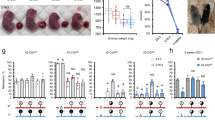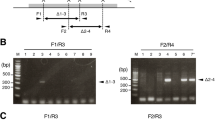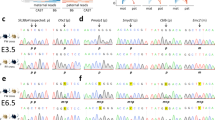Abstract
MOUSE embryos with duplications of whole maternal (partheno-genetic and gynogenetic) or paternal (androgenetic) genomes show reciprocal phenotypes and do not develop to term1,2. Genetic complementation has identified the distal region of chromosome 7 (Chr 7) as one of the regions for which both a maternal and paternal chromosome copy are essential for normal development, presumably because of the presence of imprinted genes whose expression is dependent on their parental origin3,4. Embryos with the maternal duplication and paternal deficiency of distal Chr 7 are growth retarded and die around day 16 of gestation; the reciprocal paternal duplication embryos die at an unidentified earlier stage4. We report here the incorporation of cells with the paternal duplication into chimaeras, resulting in a striking growth enhancement of the embryos. One gene located on mouse distal Chr 7 (ref. 5) is the insulin-like growth factor 2 (Igf2) gene, an embryonic mitogen6. In embryos with the maternal duplication of distal Chr 7, the two maternal alleles of the Igf2 gene are repressed. The presence of two paternal alleles of this gene in many cells is probably responsible for the growth enhancement observed in chimaeras. We propose that there are other imprinted genes in this Chr 7 region. We also compare the imprinting of this sub-genomic region with phenotypes resulting from the duplication of the whole parental genome in parthenogenones and androgenones.
This is a preview of subscription content, access via your institution
Access options
Subscribe to this journal
Receive 51 print issues and online access
$199.00 per year
only $3.90 per issue
Buy this article
- Purchase on Springer Link
- Instant access to full article PDF
Prices may be subject to local taxes which are calculated during checkout
Similar content being viewed by others
References
Surani, M. A. H. in Experimental Approaches to Mammalian Embryonic Development (ed. Rossant, J. & Pedersen, R. A.) 401–435. (Cambridge University Press, Cambridge, 1986).
Solter, D. A. Rev. Genet. 22, 127–146 (1988).
Cattanach, B. M. J. Embryol. exp. Morph. 97, 137–150 (1986).
Searle, A. G. & Beechey, C. V. Genet. Res. 56, 237–244 (1990).
Rotwein, P. & Hall, L. DNA Cell Biol. 9, 725–735 (1990).
Beck, F. et al. Development 101, 175–184 (1987).
Lyon, M. F. & Searle, A. G. Genetic Variants and Strains of the Laboratory Mouse 2nd edn 592 (Oxford University Press, Oxford, 1989).
Searle, A. G., Ford, C. E. & Beechey, C. V. Genet. Res. 18, 215–235 (1971).
Lee, J., Pintar, J. & Efstratiadis, A. Development 110, 151–159 (1990).
De Chiara, T. M., Robertson, E. J. & Efstratiadis, A. Cell 64, 849–860 (1991).
Barlow, D. P., Stoger, R., Herrmann, B. G., Saito, K. & Schweifer, N. Nature 349, 84–87 (1991).
Surani, M. A. et al. Development Suppl. 89–98 (1990).
Fundele, R. et al. Development 108, 203–211 (1990).
Stylianopoulou, F. et al. Development 103, 497–506 (1988).
Mann, J. R., Gadi, I., Harbison, M. L., Abbondanzo, S. J. & Stewart, C. L. Cell 62, 251–260 (1990).
Fundele, R., Norris, M., Barton, S. C., Reik, W. & Surani, M. A. Development 106, 28–35 (1989).
De Chiara, T. M., Efstratiadis, A. & Robertson, E. J. Nature 345, 78–80 (1990).
Reik, W. Trends Genet. 5, 331–336 (1989).
Hall, J. Am. J. hum. Genet. 46, 857–873 (1990).
Ferguson-Smith, A. C., Reik, W. & Surani, M. A. Cancer Surveys 9, 487–503 (1990).
Ohlsson, R., Holmgren, L., Glaser, A., Szpecht, A. & Pfeifer-Ohlsson, S. EMBO J. 8, 1993–1999 (1989).
Nicholls, R. et al. Am. J. hum. Genet. 46, A230 (1990).
Barton, S. C., Adams, C. A., Norris, M. L. & Surani, M. A. H. J. Embryol. exp. Morph. 90, 267–285 (1985).
Solter, D. & Knowles, B. Proc. natn. Acad. Sci. U.S.A. 72, 5099–5102 (1975).
Babinet, C. Expl Cell Res. 130, 15–19 (1980).
Gardner, R. L. in Methods in Mammalian Reproduction (ed. Daniel, J. C. Jr) 137–165 (Academic Press, New York, New York, 1978).
Winking, H. & Silver, L. M. Genetics 108, 1013–1020 (1984).
Chomcynski, P. & Sacchi, N. Ann. Biochem. 162, 156–159 (1987).
Maniatis, T., Fritsch, E. F. & Sambrook, J. Moleular Cloning: a Laboratory Manual (CSH, USA, 1982).
Bartolomei, M. S., Zemel, S. & Tilghman, S. M. Nature 351, 153–155 (1991).
Author information
Authors and Affiliations
Rights and permissions
About this article
Cite this article
Ferguson-Smith, A., Cattanach, B., Barton, S. et al. Embryological and molecular investigations of parental imprinting on mouse chromosome 7. Nature 351, 667–670 (1991). https://doi.org/10.1038/351667a0
Received:
Accepted:
Issue Date:
DOI: https://doi.org/10.1038/351667a0
This article is cited by
-
Noncanonical regulation of imprinted gene Igf2 by amyloid-beta 1–42 in Alzheimer’s disease
Scientific Reports (2023)
-
Allele-specific differential regulation of monoallelically expressed autosomal genes in the cardiac lineage
Nature Communications (2022)
-
Maternal H3K27me3-dependent autosomal and X chromosome imprinting
Nature Reviews Genetics (2020)
-
Role of genomic imprinting in mammalian development
Journal of Biosciences (2020)
-
Thromboinflammatory changes in plasma proteome of pregnant women with PCOS detected by quantitative label-free proteomics
Scientific Reports (2019)
Comments
By submitting a comment you agree to abide by our Terms and Community Guidelines. If you find something abusive or that does not comply with our terms or guidelines please flag it as inappropriate.



